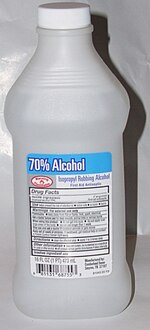Rubbing alcohol

Rubbing alcohol, USP / Surgical spirit, B.P. is a liquid prepared and used primarily for topical application. It is prepared from a special denatured alcohol solution and contains approximately 70 percent by volume of pure, concentrated ethanol (ethyl alcohol) or isopropyl alcohol (isopropanol).[1] Individual manufacturers can use their own "formulation standards" in which the ethanol content usually ranges from 70-99% v/v.[2] In Ireland and the UK, the equivalent skin preparation is surgical spirit, which is always an ethyl alcohol-isopropyl alcohol mixture. It is colorless. The melting point is -89 °C. The boiling point is 82.5 °C.
The term "rubbing alcohol" has become a general non-specific term for either isopropyl alcohol (isopropanol) or ethyl alcohol (ethanol) rubbing-alcohol products.
Properties
Rubbing alcohol is a volatile and flammable liquid. It is colorless, though it can be coloured as desired. It has an extremely bitter taste from its additives and (in the absence of added odorous substances) a characteristic odor. The specific gravity of Formula 23-H is between 0.8691 and 0.8771 at 15.56 °C.
Isopropyl rubbing alcohol USP/B.P. contains 68–99% of isopropanol (isopropyl alcohol) by volume, the remainder consisting of water, with or without color additives, suitable stabilisers, and perfume oils.[citation needed] Isopropyl alcohol is oxidised by the liver into acetone.[3] Symptoms of isopropyl alcohol poisoning include flushing, headache, dizziness, central nervous system depression, nausea, vomiting, anesthesia, and coma.[3]
Legislation
In the USA, rubbing alcohol, USP and all preparations coming under the classification of Rubbing Alcohols (defined as those containing ethanol) must be manufactured[citation needed] in accordance with the requirements of the US Treasury Department, Bureau of Alcohol, Tobacco, and Firearms, using Formula 23-H (8 parts by volume of acetone, 1.5 parts by volume of methyl isobutyl ketone, and 100 parts by volume of ethyl alcohol). It contains 87.5-91% by volume of absolute ethyl alcohol. The rest consists of water and the denaturants, with or without color additives, and perfume oils. Rubbing Alcohol contains in each 100 mL not less than 355 mg of sucrose octaacetate or not less than 1.40 mg of denatonium benzoate. The preparation may be colored with one or more color additives. A suitable stabilizer may also be added.[4]
Warnings
Product labels for rubbing alcohol include a number of warnings about the chemical, including the flammability hazards and its intended use only as a topical antiseptic and not for internal wounds or consumption. It should be used in a well-ventilated area due to inhalation hazards. Poisoning can occur from ingestion, inhalation, or consumption of rubbing alcohol.[5][6]
References
- ^ See Industrial Alcohol In Washington State, "Rubbing Alcohol is a cooling and soothing liquid for external application that contains approximately 70 percent denatured ethyl alcohol or isopropanol."
- ^ Wilson, Charles (2004). "8". Wilson and Gisvold's textbook of organic medicinal and pharmaceutical chemistry (11 ed.). Lippincott Williams & Wilkins. p. 219. ISBN 978-0-7817-3481-3.
{{cite book}}: Unknown parameter|coauthors=ignored (|author=suggested) (help) - ^ a b Levine, Michael D (August 27, 2008). "Toxicity, Alcohols". Retrieved 2009-08-20.
{{cite web}}: Unknown parameter|coauthors=ignored (|author=suggested) (help) - ^ Expert Committee:(PA2)Pharmaceutical Analysis 2, USP28–NF23 Page 62, Pharmacopeial Forum:Volume No.27(3)Page 2507 [1]
- ^ DeBellonia RR, Marcus S, Shih R, Kashani J, Rella JG, Ruck B (2008). "Curanderismo: consequences of folk medicine". Pediatr Emerg Care. 24 (4): 228–9. doi:10.1097/PEC.0b013e31816b7a92. PMID 18418260.
{{cite journal}}: Unknown parameter|month=ignored (help)CS1 maint: multiple names: authors list (link) - ^ Trullas JC, Aguilo S, Castro P, Nogue S (2004). "Life-threatening isopropyl alcohol intoxication: is hemodialysis really necessary?". Vet Hum Toxicol. 46 (5): 282–4. PMID 15487656.
{{cite journal}}: Unknown parameter|month=ignored (help)CS1 maint: multiple names: authors list (link)
